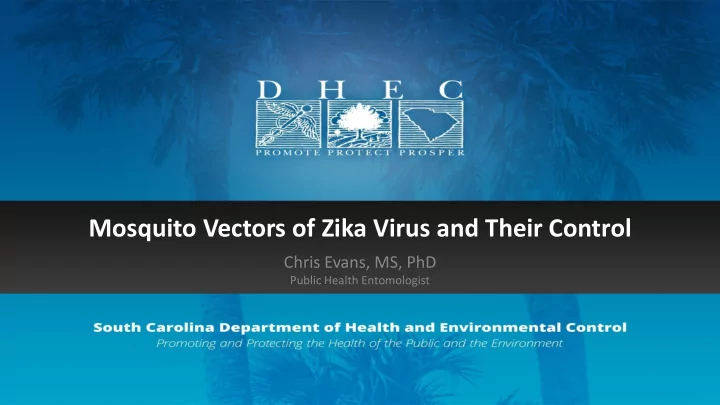

Mosquito Vectors of Zika Virus and Their Control Chris Evans, MS, PhD Public Health Entomologist
mosquito Acquires virus Transmits virus incubation period 7-10 days human incubation period virus in bloodstream virus in bloodstream 2-7 days illness illness 2 - 7 days 2 - 7 days Human 1 Human 2 Symptom Onset Symptom Onset
Mosquito Vectors of Zika Virus Ten Aedes Species in Africa & the South Pacific • Stegomyia group – Ae. aegypti , Ae. africanus , Ae. albopictus , Ae. apicoargenteus , Ae. hensilli , Ae. luteocephalus , and Ae. polynesiensis • Aedimorphus group – Ae. vittatus • Diceromyia group – Ae. furcifer , Ae. taylori
Aedes aegypti Yellow Fever Mosquito Feeds almost exclusively on people Breeds and rests indoors and outdoors Near human habitation
Aedes aegypti Historical Range (1960 – 2014) Due to being out-competed by Aedes albopictus , Aedes aegypti is now limited to coastal regions of the southeastern United States
Aedes aegypti Outdoor Breeding Urban Areas Near Human Habitation Cemetery Vase Water Storage Waste Containers Bird Baths Discarded Tires
Aedes aegypti Indoor Breeding Sik, Malaysia Water Fountain Sik, Malaysia Bathroom Container
Aedes albopictus Asian Tiger Mosquito Opportunistic blood feeder, mostly mammals Breeds and rests outdoors Near human habitation or rural, wooded areas 8
Aedes albopictus U.S. Range
Aedes albopictus Outdoor Breeding Sites Urban or Rural Areas • Containers Metal, glass, stone, earthenware, plastic, wood, or rubber • Natural containers Treeholes Leaf axils (not common) • Human-made containers Flower pots Cans Buckets Ornamental ponds Birdbaths Old tires Cemetery vases Clogged rain gutters Pet watering dishes
Eliminate Mosquito Vectors and Avoid Exposure
Controlling Mosquito Larvae Main Focus of Mosquito Control Adult • Mosquito larvae are 5-7 Confined to water and are Pupa Eggs days easier to treat than adults Larvae More vulnerable to control measures than the adults
Source Reduction Removing sources of water that breed mosquitoes
Natural Containers Artificial Containers Tree Holes Cut Bamboo Plastic
Think Tall Think Small
Recycling Waste Tires Eliminates the need using expensive EPA-registered insecticides
Community Involvement in Source Reduction “Man breeds his own Aedes aegypti and sits back either in ignorance or in the hope that someone else will do the tidying up.” J.D. Gillett Educational Challenges • Link larvae – “wrigglers” – with adult mosquitoes that might cause illness • Stop dependence on government or other institutions to sustain source reduction activities
Larviciding Process of killing mosquitoes by applying natural agents or commercial products to control larvae and pupae
Mosquito Control At Home Bacillus thuringiensis israelensis – Bti Bacterial toxins paralyzes the midgut of mosquito larvae
Mosquito Control at Home Methoprene, an Insect Growth Regulator Briquette Methoprene, an Insect Growth Regulator Mimics juvenile hormone & Granules prevents larvae from molting into pupae
Mosquito Repellents EPA-Registered Active Ingredients • DEET • Picaridin • IR3535 • Oil of Lemon Eucalyptus
Adult Mosquito Control – Adulticiding • Source reduction or larviciding fails to control mosquitoes OR • Outbreak already in progress 22
Ultra-Low Volume (ULV) Spraying Use of nozzles to atomize the insecticide
Thermal Fogging Use of heat to atomize the insecticide Vehicle-mounted, Handheld, or Backpack versions available Hand-held thermal fogger
Establishing a Mosquito Control Program ASTHO’s Recommendations Level 1 (Minimal) • Minimal or no resources. Emphasize education, community participation, and personal responsibility. Level 2 (Intermediate) • Little to moderate resources. Combine resources with other jurisdiction. Add increased source reduction and adulticide. Map habitats. Monitor larval & adult populations. Level 3 (Comprehensive) • Moderate to full resources. Procure equipment and insecticides. Expand data collection. Build risk maps and assign priorities to areas. Source: Thielen L, Dunlop TS, Mesch K, Moore CG, Stern M, Morrisey S, et al. 2005. Public health confronts the mosquito. Washington, DC: Association of State and Territorial Health Officials.
When to Notify Mosquito Control Programs of Zika-Virus Positive Events Suspect or Confirmed Patient is viremic or infectious to mosquitoes while in South Carolina YES Weather/Time of Year is appropriate for mosquitoes to be present YES Local exposure to mosquitoes was likely Mosquito Control YES is Notified
Chris Evans Bureau of Laboratories | Medical Entomology Public Health Entomologist 8231 Parklane Rd | Columbia SC 29223 SC Dept of Health & Environmental Control (P) 803.896.3802 | (F) 803.896.0983 EVANSCL@dhec.sc.gov
Recommend
More recommend